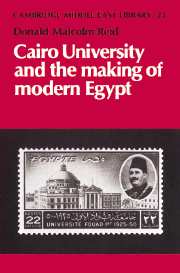Book contents
- Frontmatter
- Contents
- List of illustrations
- List of tables
- Acknowledgments
- Note on academic terminology and transliteration
- List of abbreviations
- Introduction
- Part I The private university, 1908–1919
- Part II The university and the liberal ideal, 1919–1950
- 4 The transition to a state university
- 5 Rival imperialisms and Egyptianization
- 6 Issues of equity: a university for whom?
- 7 The university and politics, 1930–1950
- 8 The issue of religion
- Part III In Nasser's shadow, 1950–1967
- Part IV The university since Nasser
- Conclusion and prospect
- Notes
- Select bibliography
- Index
7 - The university and politics, 1930–1950
Published online by Cambridge University Press: 30 October 2009
- Frontmatter
- Contents
- List of illustrations
- List of tables
- Acknowledgments
- Note on academic terminology and transliteration
- List of abbreviations
- Introduction
- Part I The private university, 1908–1919
- Part II The university and the liberal ideal, 1919–1950
- 4 The transition to a state university
- 5 Rival imperialisms and Egyptianization
- 6 Issues of equity: a university for whom?
- 7 The university and politics, 1930–1950
- 8 The issue of religion
- Part III In Nasser's shadow, 1950–1967
- Part IV The university since Nasser
- Conclusion and prospect
- Notes
- Select bibliography
- Index
Summary
The ideal of a university above politics is one thing, but reality is quite another. Taha Husayn's return in 1936 to the deanship from which Ismail Sidqi's strong-arm government had removed him four years earlier was a partial triumph for university autonomy. By then, student demonstrations had become a way of life. Students spearheaded demonstrations for independence, skirmished on behalf of the fractured national parties, and protested policies which threatened their academic success or future job prospects. For professors, academia was emerging as a route to a cabinet seat, increasing the temptation for academics to become politically involved. In the 1940s Taha's and Lutfi's successors proved unable to channel the political energies of their students constructively. The malaise that gripped Egypt and the Arab world pervaded the campus. The Gordian knot, as Nasser put it, had to be cut, the “role wandering aimlessly in search of a hero,” filled.
University autonomy and the purge of Taha Husayn
Taha's dismissal in March 1932 came during King Fuad's last and most sustained bid for autocracy. He was working through Prime Minister Ismail Sidqi, who in 1930 replaced the 1923 constitution with one which concentrated power completely in the king's hands. The British did not object.
- Type
- Chapter
- Information
- Cairo University and the Making of Modern Egypt , pp. 120 - 138Publisher: Cambridge University PressPrint publication year: 1990



